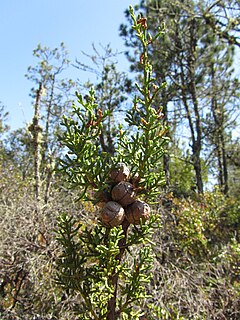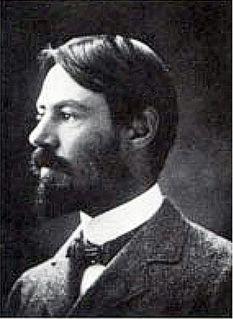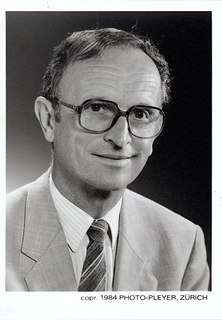
Hesperocyparis macrocarpa is a coniferous tree. It is commonly known as the Monterey cypress and is one of several species of cypress trees endemic to California. In New Zealand, where it is also widespread, it is simply known as "macrocarpa".

Cupressus bakeri, reclassified as Hesperocyparis bakeri, with the common names Baker cypress, Modoc cypress, or Siskiyou cypress, is a rare species of cypress tree endemic to a small area across far northern California and extreme southwestern Oregon, in the western United States.

Cupressus pigmaea, the Mendocino cypress or pygmy cypress, is a taxon of disputed status in the genus Cupressus endemic to certain coastal terraces and coastal mountain ranges of Mendocino and Sonoma Counties in northwestern California. It is a highly variable tree, and closely related to Cupressus goveniana, enough to sometimes be considered a subspecies of it.

Merritt Lyndon Fernald was an American botanist. He was a respected scholar of the taxonomy and phytogeography of the vascular plant flora of temperate eastern North America. During his career, Fernald published more than 850 scientific papers and wrote and edited the seventh and eighth editions of Gray's Manual of Botany. Fernald coauthored the book Edible Wild Plants of Eastern North America in 1919–1920 with Alfred Kinsey, which was published in 1943.

William Francis Ganong, M.A., Ph.D., LL.D., F.R.S.C., was a Canadian biologist botanist, historian and cartographer. His botany career was spent mainly as a professor at Smith College in Northampton, Massachusetts. In his private life he contributed to the historical and geographical understanding of his native New Brunswick.

Wolffia is a genus of nine to 11 species which include the smallest flowering plants on Earth. Commonly called watermeal or duckweed, these aquatic plants resemble specks of cornmeal floating on the water. Wolffia species are free-floating thalli, green or yellow-green, and without roots. The flower is produced in a depression on the top surface of the plant body. It has one stamen and one pistil. Individuals often float together in pairs or form floating mats with related plants, such as Lemna and Spirodela species. Most species have a very wide distribution across several continents. Wolffia species are composed of about 40% protein on a dry-matter basis, about the same as the soybean, making them a potential high-protein human food source. They have historically been collected from the water and eaten as a vegetable in much of Asia.

Willis Linn Jepson was an early California botanist, conservationist, and writer.

Elmer Drew Merrill was an American botanist and taxonomist. He spent more than twenty years in the Philippines where he became a recognized authority on the flora of the Asia-Pacific region. Through the course of his career he authored nearly 500 publications, described approximately 3,000 new plant species, and amassed over one million herbarium specimens. In addition to his scientific work he was an accomplished administrator, college dean, university professor and editor of scientific journals.
Philip Alexander Munz, botanist, plant taxonomist and educator (1892–1974), worked at the Rancho Santa Ana Botanic Garden, and was a professor of botany at Pomona College, serving as dean there for three years.

Cupressus forbesii, now reclassified by some as Hesperocyparis forbesii, and with the common names Tecate cypress or Forbes' cypress, is a species of cypress native to southwestern North America.

Erigeron glaucus is a species of flowering plant in the daisy family known by the common name seaside fleabane, beach aster, or seaside daisy.
Charles Noyes Forbes (1883–1920) was an American botanist who primarily worked on Hawaii.

Joseph Burtt Davy was a Quaker botanist and agrostologist. He was the first curator of the Forest Herbarium (FHO) at the Imperial Forestry Institute when it was founded in 1924 under the Directorship of Professor Robert Scott Troup.
The coconut pearl is alleged to be a coconut-produced gemstone. Claimed to be the rarest botanical gem in the world, the coconut pearl supposedly grows inside the coconut. However, the existence of these pearls is in dispute, and some claim that published photos are hoaxes.

Calochortus invenustus is a species of flowering plant in the lily family known by the common name plain mariposa lily.
The University and Jepson Herbaria are two separate herbaria at the University of California, Berkeley. These botanical natural history museums are located on the ground floor of the Valley Life Sciences Building on the main campus of the university in Berkeley, California. There are a number of ancillary collections such as the Fruit & Cone Collection, Horticultural Herbarium and Spirit Collection. Holotypes are maintained separately for both Herbaria. The Charterhouse School Herbarium is housed separately within the University Herbarium. The Herbaria have an open house every year on CalDay with a range of activities for children and adults.

Cupressus stephensonii is a species of conifer known as the Cuyamaca cypress, and is endemic to southern California. It has been classified as Hesperocyparis stephensonii. It was previously listed as Cupressus arizonica subsp. stephensonii and Cupressus arizonica var. glabra.
Harvey Monroe Hall was an American botanist particularly noted for his taxonomic work in the western United States.

Elias Landolt (1926–2013) was a Swiss geobotanist, known for his publications on Switzerland's native flora and Lemnoideae.
Milo Samuel Baker was an American botanist, specializing in plants of the northern coastal region of California, as well as the genus Viola.













